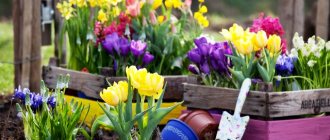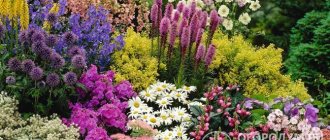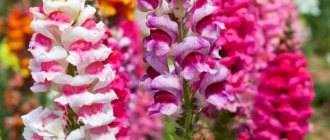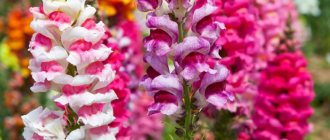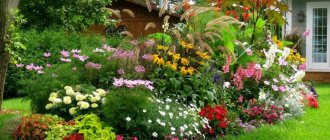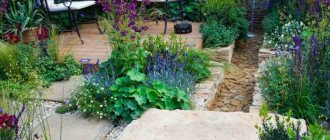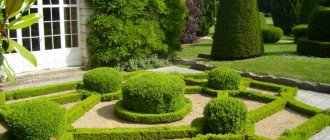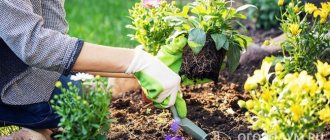Plants for flowerbed decoration
Selecting beautiful and unpretentious flowering plants for your garden is not such a difficult task. The only difficulty here will be not to plant all the flowers in a chaotic order. That is why it is worth understanding in more detail which flowers are best suited for planting in flower beds.
Sun-loving perennials
Onion perennials begin to please the eye from the moment the first spring rays appear. Flowers give way to each other .
Snowdrops are being replaced by crocuses and hyacinths. Next, tulips, irises and daffodils begin to bloom. In May, sunny flowers - lilies - bloom. When summer comes, the bulbous flowers go into a dormant period. The leaves begin to fade, and the bulbs will rest until next spring. But this does not mean at all that in the summer the garden should look like an abandoned wasteland. It can be diversified with flowering perennials and herbs:
Perennials that bloom in summer will please the eye much longer . Of course, one cannot fail to mention the rose here. Most varieties of roses are ideally combined with coniferous shrubs, the greenery of which sets off the bright buds.
A flower garden with gladioli will be especially colorful. These flowers grow and bloom in the flowerbed, giving the garden a certain majesty and luxury. Gladioli are bulbous plants. They will feel great in the garden surrounded by the following perennials:
Pelargonium, which is often popularly called geranium, can often be seen in pots on windowsills. But this does not mean that the plant is not suitable for an outdoor flower bed. Pelargonium is very easy to care for and produces a lot of inflorescences. It is preferable to grow on the sunny side or in the least shaded place.
Chrysanthemums are very popular and will fit perfectly into a garden composition.
Chrysanthemums begin to bloom in August. The flowering period of these flowers ends only with the onset of the first frost .
Chrysanthemums will look great in the autumn garden. Chamomile can brighten up any yard. Such flowers can often be found even in the courtyards of schools. Chamomile can fit perfectly into the garden with other perennial plants. She is very easy to care for and will never cease to please the eye. Chamomiles can also be combined with small shrubs.
Annual flowers in the yard
Annuals are the perfect solution for those who like variety in their garden.
Annual flowering plants make it possible to create unique compositions in flower beds every season. Such flowers can be used both to decorate mixborders and modular flower beds. Annuals are often planted in pots to decorate their summer cottage. The most common annual flowers are:
Many people probably think that the above flowers have long become boring and lack any originality. However, with the right choice of varieties and the correct composition, these “boring” plants will take on a completely different look.
Few people know that marigolds in their genus include more than 3 species. In Russia, upright and deviated species can most often be found. If we talk about the color scheme, it starts from dark red and ends with a lemon shade. Some varieties are distinguished by their mixed colors.
Zinnia, often called major by gardeners, is a large, bright, hollow flower. Zinnia tolerates the sun well without losing its rich colors. This flower plant is perfect for a rustic flower bed. Only asters can compete with them.
Unpretentious tall perennials
Several well-known plants are deservedly considered among the most unassuming perennial flowers, capable of growing in any soil and blooming throughout the season.
Phlox paniculata
One of the most frost-resistant perennials, capable of blooming throughout the summer. Ideal for planting in shade and sunny locations. It has beautiful inflorescences and a delicate aroma.
Does not require watering or tying up, although the height of the bushes reaches 80 cm.
Lupine
The plant has a beautiful peduncle and is absolutely not demanding on soil quality and growing conditions. The only recommendation regarding growing lupine is that it is not advisable to plant it in places where strong gusts of wind are possible.
The flowering period occurs in June. Lupine reproduces well by self-sowing. Its advantages include the ability to improve the composition of the soil.
Tall perennial plants are in demand among gardeners due to a number of their advantages.
They are not demanding of care and can grow in one place for several years without complex additional care. Tall perennials harmoniously complement any composition, play the role of a hedge, and are effective for zoning a garden plot.
A huge variety of varieties and hybrids allows you to effortlessly create an original garden composition that will decorate the garden for several years without labor-intensive care.
Main characteristics
In landscape design, there is a special class of herbs that either do not bloom at all or bloom unnoticed. These are ornamental herbaceous plants. Some look so impressive that it is no longer possible to imagine a modern flowerbed or front garden without them. There are a great many herbaceous plants in nature. There are about 18,000 of them in Russia alone. But of course, not all herbs can be classified as ornamental.
Herbaceous plants are plants that do not have perennial above-ground characteristics, they do not have woodiness of the stem, and at the end of the growing season they die off. Herbs form a root system and shoots: leaves, stem and flower part, if any.
Classification of herbaceous plants
Herbaceous plants are classified according to various criteria. But grouping plants by lifespan is considered the most convenient. Their examples:
Number of species of ferns around the world, class 3
1. In each of these drawings, Seryozha and Nadya’s dad depicted representatives of one of the groups of plants. Number the pictures according to the list.
Tell us about the diversity of plants from the pictures.
Plants grow on Earth in a variety of ways. Some, such as algae and water lilies, prefer an aquatic environment, but most plants grow on land, spreading their roots into the soil. Some plants reproduce by seeds, and some by spores. Some plants have smooth, wide leaves, and some have sharp, long spines. There are plants of various colors and shades, small and large, useful and harmful, wild and cultivated.
2. Complete the group work assignments in the textbook and workbook.
1) Write down a plant classification task for your classmates.
Algae, mosses, ferns, flower gardens, conifers.
2) Count the plants in the textbook picture (p. 72) and write down the results.
3) Using information from the textbook text, complete the table.
Analyze the completed table.
Which group of plants is richest in species?
Which group has the fewest species?
List the groups of plants:
in order of increasing number of species;
in order of decreasing number of species
4) Write down the names of the plants you identified:
a) in the classroom - aloe. violet, pink vinca (blue), pink catharanthus. b) in other rooms of the school - Gardenia Augusta (syn.), gardenia jasminoides, rough zamia c) near the school - spruce, pine, fir.
Use the Green Pages book to give examples of other types of plants. Write down at least three names.
lily, lotus, chamomile, willow, birch, bamboo, flax.
3. Seryozha and Nadya’s mother found a witty poem by V. Orlov in one of the books, just on the topic of the lesson. Read it.
Apple tree and oak tree are different types
.
The fruits of the apple tree are apples
, and the fruits of the oak tree are
acorns
.
4. According to the instructions in the textbook, determine the names of several plants. Write it down.
Houseplants in my home: aloe, violet
Plants in my yard:
spruce, birch
1. In each of these drawings, Seryozha and Nadya’s dad depicted representatives of one of the groups of plants. Number the pictures according to the list.
1. Algae. 2. Mosses. 3. Ferns. 4. Conifers. 5. Flowering.
- Tell us about the diversity of plants from the pictures.
2. Complete the group work assignments in the textbook and workbook.
1) Write down a plant classification task for your classmates.
Algae, mosses, ferns, flower gardens, conifers.
2) Count the plants in the textbook picture (p. 72) and write down the results.
3) Using information from the textbook text, complete the table.
- Analyze the completed table. Which group of plants is richest in species? Which group has the fewest species? List the groups of plants: in order of increasing number of species; in order of decreasing number of species.
4) Write down the names of the plants you identified:
a) in the classroom - aloe. violet, pink vinca (blue), pink catharanthus. b) in other rooms of the school - Gardenia Augusta (syn.), gardenia jasminoides, rough zamia c) near the school - spruce, pine, fir.
Use the Green Pages book to give examples of other types of plants. Write down at least three names.
Lily, lotus, chamomile, willow, birch, bamboo, flax.
3. Seryozha and Nadya’s mother found a witty poem by V. Orlov in one of the books, just on the topic of the lesson. Read it.
This is an apple orchard, This is an apple orchard! And in the garden, wherever you look, there are apples hanging everywhere!
And on one tree, And on one tree, for some reason there are no apples - They don’t grow on it!
I wonder why? I wonder why? Really, really No one knows?
Everyone who is not stupid knows, Everyone who is not stupid knows, Because, because, Because - it's an oak tree.
- Fill in the blanks.
Apple tree and oak tree are different types of plants. The fruits of the apple tree are apples, and the fruits of the oak tree are acorns.
4. According to the instructions in the textbook, determine the names of several plants. Write it down.
Houseplants in my home: aloe, violet.
Plants in my yard: spruce, birch.
Save or share with classmates:
Decoration of the world
Decorative plantings are widely used to improve the landscape: near houses, grasses are displayed in flower beds and front gardens, they decorate squares and park areas in cities. Thematic compositions and modular flower beds, porters and borders are created from annuals, biennials and perennials.
Conventionally, ornamental plants are divided into deciduous and flowering:
Today, the range of herbs is diverse, which makes the choice much more difficult. But the decision should be made based on more than just appearance. It is important to know the growing conditions and other characteristics, which may differ significantly depending on the type of plant.
Decorative deciduous grasses
Plants with decorative foliage delight the eye with splendor and variety from spring until the first frost.
Wormwood is a biennial or perennial herbaceous plant. There are many types of wormwood, and some are even listed in the Red Book of Russia.
Most types of wormwood grow up to 60-70 cm in height, but there are also those whose growth can exceed 1.5 m. The stems of the plant are straight and branched, pubescent. The leaves are elongated and pointed, silvery in color. The flowers are small, collected in inflorescences, usually white or yellow. Wormwood has a pleasant aroma with a slight bitterness.
To grow decorative wormwood, you need well-drained soil and a site located on the sunny side.
Mint is not only a healthy and fragrant herb, it also has decorative properties. Mint is a perennial plant with many species, but the most common are fragrant and peppermint.
The stems of fragrant mint reach a height of up to 40 cm, they are straight and stable. The leaves are green with a light edge, wrinkled, and exude a pleasant aroma.
Peppermint can reach a height of 120 cm. Its stems are straight, tetrahedral, branched, and well-leafed. The leaves are green with a purple edge, elongated-ovate, pointed and jagged.
Mint is an unpretentious plant, but it grows and reproduces better in fertile and well-moistened soil. More illuminated areas are optimal for growing.
Sheep fescue is an ornamental grass. The plant does not form a rhizome and differs from other fescue trees in its softer foliage.
Sheep fescue grows in a dense bush, growing from 20 to 140 cm in height. The leaves are bristly and can be different in shape: from wide to especially narrow. Fescue blooms with oblong panicles of light green spikelets.
It is recommended to grow sheep fescue in a bright and warm place with low humidity. It tolerates drought well and responds well to pruning.
Beautiful flowering plants
Beautifully flowering herbs will enliven and decorate any corner of the garden, and the name itself already speaks for itself.
Adonis is a flowering herbaceous plant; in summer, this beautiful flower can be found in the European part of Russia and Western Siberia. There are two types of Adonis: spring and summer.
A plant often has more than one stem; they can be simple or weakly branched, erect or deflected. They grow up to 40-50 cm in height. The leaves are very thin and stick out in different directions, because of this it seems that the stem of the flower is shaggy. Sunny places are preferred for growing.
Plant diversity - pages 39, 40, 41
1. In each of these drawings, Seryozha and Nadya’s dad depicted representatives of one of the groups of plants.
Number the pictures according to the list. 1. Algae. 2. Mosses. 3. Ferns. 4. Conifers. 5. Flowering.
- Tell us about the diversity of plants from the pictures.
2. Complete the group work assignments in the textbook and workbook.
1) Write down a plant classification task for your classmates.
Algae, mosses, ferns, flower gardens, conifers.
2) Count the plants in the textbook picture (p. 72) and write down the results.
3) Using information from the textbook text, complete the table.
- Analyze the completed table. Which group of plants is richest in species? Which group has the fewest species? List the groups of plants: in order of increasing number of species; in order of decreasing number of species.
4) Write down the names of the plants you identified:
a) in the classroom - aloe. violet, pink vinca (blue), pink catharanthus. b) in other rooms of the school - Gardenia Augusta (syn.), gardenia jasminoides, rough zamia c) near the school - spruce, pine, fir.
Use the Green Pages book to give examples of other types of plants. Write down at least three names.
Lily, lotus, chamomile, willow, birch, bamboo, flax.
3. Seryozha and Nadya’s mother found a witty poem by V. Orlov in one of the books, just on the topic of the lesson. Read it.
This is an apple orchard, This is an apple orchard! And in the garden, wherever you look, there are apples hanging everywhere!
And on one tree, And on one tree, for some reason there are no apples - They don’t grow on it!
I wonder why? I wonder why? Really, really No one knows?
Everyone who is not stupid knows, Everyone who is not stupid knows, Because, because, Because - it's an oak tree.
- Fill in the blanks.
Apple tree and oak tree are different types of plants. The fruits of the apple tree are apples, and the fruits of the oak tree are acorns.
4. According to the instructions in the textbook, determine the names of several plants. Write it down.
Houseplants in my home: aloe, violet.
Plants in my yard: spruce, birch.
Save or share with classmates:

